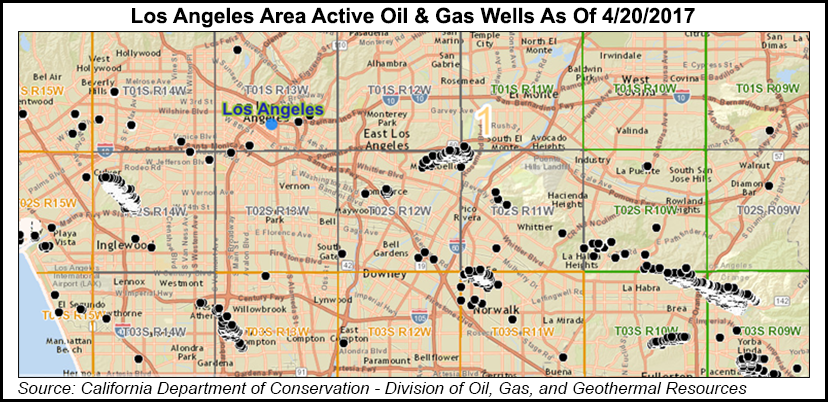Regulatory | NGI All News Access
Los Angeles City Council Considers Residential Drilling Setbacks
Los Angeles City Council on Wednesday put in play the possibility of carving out buffer zones around the city’s drilling sites that are near homes, schools, churches and health care facilities. The council president has asked for a study of the feasibility of establishing the setbacks.

Calling the proposal a “health and safety buffer,” Council President Herb Wesson said he hoped the study will provide insight into the “systemic improvements” needed to protect city residents and business owners “from the health impacts of oil/gas extraction in residential neighborhoods.”
According to the city council’s data, 580,000 residents in the city of more than 4 million inhabitants live less than one-quarter of a mile from an active oil well.
“A growing body of scientific and public health evidence indicates that individuals living within 2,500 feet of active oil and gas development have an increased risk of acute and sub-chronic respiratory, neurological, reproductive health effects, and cancer in their lifetime due to exposure to benzene, a known carcinogen, and other toxins,” a council spokesperson said.
The four-month-long storage well leak that ended in February last year at Southern California Gas Co.’s Aliso Canyon underground facility stirred activism among residents closer to downtown. They complain that the drill sites are making them sick.
Earlier this year, residents in the Jefferson Park area of Los Angeles stepped up their protests against the operations at a long-standing controversial urban drilling site, which recently changed ownership to privately held Sentinel Peak Resources California LLC. Sentinel was the operator at the site even before completing its $742 million purchase at the beginning of the year from Phoenix-based Freeport-McMoRan Inc.
In January, residents near that drilling area attended a city zoning hearing demanding “adequate and equitable protections” against Sentinel Peak’s operations, which they allege have inadequate buffering. They claimed that oil/waste wells operate as close as 60 feet away from residents’ bedroom windows.
In launching the study, some council members spoke out about oil and natural gas as having “no place in the Los Angeles of the future.” Councilman Mike Bonin said “the oil/gas industry simply isn’t safe” and buffer zones would help increase personal safety.
A coalition of community groups, Stand Together Against Neighborhood Drilling (STAND–L.A.), showed up at the city council meeting Wednesday, repeating demands to end drilling in neighborhoods.
“Living in the largest urban oilfield in the nation, Los Angeles residents who live near drilling have long called for the city to take climate leadership by establishing a half-mile buffer between homes, churches, health care facilities and other spaces deemed sensitive land-uses,” the city council spokesperson said.
© 2024 Natural Gas Intelligence. All rights reserved.
ISSN © 1532-1231 | ISSN © 2577-9877 |
